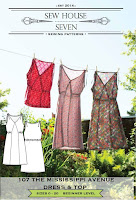 Hello! I've made a new blouse :)
Hello! I've made a new blouse :)Yes, it is currently winter here in Perth. I am braving the freezing depths of winter to take these photos.
Haha, not really! Actually I am wearing my new blouse responsibly and weather-appropriately here, in warm and sunny Italy! I made the blouse before we left on our recent hiking holiday and took it away with us so I could enjoy it in the warm weather :)
This is the Origami Blouse from the book Twinkle Sews, by Wenlan Chia. My lovely sewing neighbour Megan kindly lent her book to me. Thank you so much, Megan!
For that same reason I did not gather up the lower edge of the sleeves with elastic, but just left them straight and ungathered. The resulting lack of sleeve puffiness raises the maturity level just a touch, I reckon :)
The origami thingies on the front are rather interesting, and although they look complex are simpler than they look. Having said that, I still found them quite fiddly to make and mine are not particularly neat, although I tried! Fabric is not like paper at all, it's springy and thick, especially when seams come into the equation, and true origami perfection is a pretty tall order. I ended up abandoning all aspirations to razor sharp points and perfectly angled edges and just tried to accept the imperfection. I think I wrangled them to look passable. I can almost imagine they are like a flutter of little creamy butterflies, alighting onto my shirt for a little butterfly gathering.
I'm not too terribly distressed at their imperfection, as when I'm wearing the top they are sneakily tucked away behind that black velvet tie anyway, mwahaha...
Verdict: I think it turned out, not too cutesy cute, but nice and just mildly cute, and rather fresh and romantic and just slightly poetic.
My thoughts on Twinkle Sews, the book...
This is a nice book; it contains patterns for 25 garments; 7 skirts, 13 tops and 5 dresses. The designs include some that are easy and plain, others that are both interesting and unique, with some very innovative ideas in many of the pieces. If you're interested in something a bit different, basics with a twist, then this book contains some promising projects.
The fabrics chosen for the sample garments and the styling of them is sometimes a little questionable and I didn't always find them visually appealing. But disregarding fabrics and prints and just paying careful attention to the lines and shapes of the pieces, I reckon there are some real gems in there. Check out Megan's lovely shibori dress from the book.
The patterns come in sizes 0-16 (US) and are all on a CD included with the book. The pattern pieces are all whole pieces, meaning, no half pieces to be placed on the fold. This has advantages; it's easier to lay the full-size pieces on a flat unfolded piece of fabric to obtain the most economical layout: also disadvantages; the most obvious being that you have to do a heckuvva lot more taping!
The early chapters are aimed at a beginner seamster, with some nice and encouraging chat about the joys of fabric and making clothes for yourself; and extensive, clear and helpful explanations of basic sewing terms as well as for all the techniques used in the projects.
Details:
Blouse; the origami blouse from Twinkle Sews, by Wenlan Chia, creamy linen-silk with black velvet ribbon
Shorts; Burda 7723, green cotton gingham, details here and my review of this pattern here
Thongs (above); Havaiana
Hat (Craig's); Billabong
Socks (below); hand-knitted by me, details here
Hiking boots (below); Mountain Designs































































